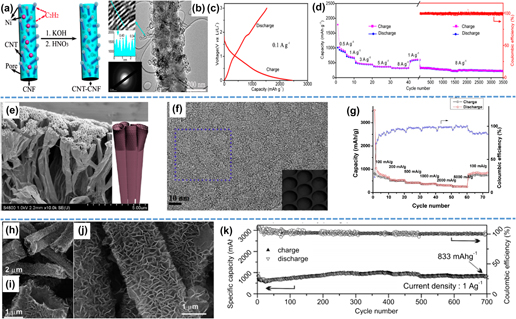Crossref Citations
This article has been cited by the following publications. This list is generated based on data provided by
Crossref.
Wang, Zhijie
Wang, Yanyan
Wang, Wenhui
Yu, Xiaoliang
Lv, Wei
Xiang, Bin
and
He, Yan-Bing
2018.
High-Level Heteroatom Doped Two-Dimensional Carbon Architectures for Highly Efficient Lithium-Ion Storage.
Frontiers in Chemistry,
Vol. 6,
Issue. ,
Pender, Joshua P.
Guerrera, Joseph V.
Wygant, Bryan R.
Weeks, Jason A.
Ciufo, Ryan A.
Burrow, James N.
Walk, Mitchell F.
Rahman, Mohammad Z.
Heller, Adam
and
Mullins, C. Buddie
2019.
Carbon Nitride Transforms into a High Lithium Storage Capacity Nitrogen-Rich Carbon.
ACS Nano,
Vol. 13,
Issue. 8,
p.
9279.
Zhou, Weiwei
Du, Yu
Zeng, Jinjue
Liu, Fei
and
Zhu, Yongming
2019.
A modified “gel-blowing” strategy toward the one-step mass production of a 3D N-doped carbon nanosheet@carbon nanotube hybrid network for supercapacitors.
Nanoscale,
Vol. 11,
Issue. 16,
p.
7624.
Esteves, Laura M.
Smarzaro, Juliana L.
Caytuero, Alexander
Oliveira, Hugo A.
and
Passos, Fabio B.
2019.
CATALYST PREPARATION METHODS TO REDUCE CONTAMINANTS IN A HIGH-YIELD PURIFICATION PROCESS OF MULTIWALLED CARBON NANOTUBES.
Brazilian Journal of Chemical Engineering,
Vol. 36,
Issue. 4,
p.
1587.
Paul, Rajib
Du, Feng
Dai, Liming
Ding, Yong
Wang, Zhong Lin
Wei, Fei
and
Roy, Ajit
2019.
3D Heteroatom‐Doped Carbon Nanomaterials as Multifunctional Metal‐Free Catalysts for Integrated Energy Devices.
Advanced Materials,
Vol. 31,
Issue. 13,
Paul, Rajib
Vincent, Mewin
Etacheri, Vinodkumar
and
Roy, Ajit K.
2019.
Carbon Based Nanomaterials for Advanced Thermal and Electrochemical Energy Storage and Conversion.
p.
1.
Huang, Chien‐Lin
Wei, Tzu‐Hsin
Peng, Sheng‐Yin
and
Lee, Kun‐Mu
2019.
Study of electrospun polyacrylonitrile fibers with porous and ultrafine nanofibril structures: Effect of stabilization treatment on the resulting carbonized structure.
Journal of Applied Polymer Science,
Vol. 136,
Issue. 46,
Han, Haixia
Chen, Xiaoyang
Qian, Jiangfeng
Zhong, Faping
Feng, Xiangming
Chen, Weihua
Ai, Xinping
Yang, Hanxi
and
Cao, Yuliang
2019.
Hollow carbon nanofibers as high-performance anode materials for sodium-ion batteries.
Nanoscale,
Vol. 11,
Issue. 45,
p.
21999.
Wang, Zhijie
Gao, Hong
Zhang, Qing
Liu, Yuqing
Chen, Jun
and
Guo, Zaiping
2019.
Recent Advances in 3D Graphene Architectures and Their Composites for Energy Storage Applications.
Small,
Vol. 15,
Issue. 3,
Ni, Wei
and
Shi, Lingying
2019.
Review Article: Layer-structured carbonaceous materials for advanced Li-ion and Na-ion batteries: Beyond graphene.
Journal of Vacuum Science & Technology A: Vacuum, Surfaces, and Films,
Vol. 37,
Issue. 4,
Packiyalakshmi, Parameswaran
Chandrasekhar, Bongu
and
Kalaiselvi, Nallathamby
2019.
Domestic Food Waste Derived Porous Carbon for Energy Storage Applications.
ChemistrySelect,
Vol. 4,
Issue. 27,
p.
8007.
Stein, Peter
Wissel, Sebastian
and
Xu, Bai-Xiang
2020.
The Influence of Surface Stress on the Chemo-Mechanical Behavior of Inverse-Opal-Structured Electrodes for Lithium-Ion Batteries.
Journal of The Electrochemical Society,
Vol. 167,
Issue. 1,
p.
013529.
Zhang, Xiaoyan
Li, YanLin
Lin, Yuanhua
Yang, Tao
Shi, Mai
and
Xu, Wen
2020.
A flexible LiFePO4/carbon nanotube/reduced graphene oxide film as self-supporting cathode electrode for lithium-ion battery.
Ionics,
Vol. 26,
Issue. 3,
p.
1537.
Liedel, Clemens
2020.
Sustainable Battery Materials from Biomass.
ChemSusChem,
Vol. 13,
Issue. 9,
p.
2110.
Patiño-Carachure, C.
Martínez-Vargas, S.
Flores-Chan, J. E.
and
Rosas, G.
2020.
Synthesis of carbon nanostructures by graphite deformation during mechanical milling in air.
Fullerenes, Nanotubes and Carbon Nanostructures,
Vol. 28,
Issue. 11,
p.
869.
Borges Honorato, Ana Maria
Khalid, Mohd.
Dai, Quanbin
and
Pessan, Luiz Antonio
2020.
Nitrogen and sulfur co-doped fibrous-like carbon electrocatalyst derived from conductive polymers for highly active oxygen reduction catalysis.
Synthetic Metals,
Vol. 264,
Issue. ,
p.
116383.
Illa, Mani Pujitha
Pathak, Anil D
Sharma, Chandra S.
and
Khandelwal, Mudrika
2020.
Bacterial Cellulose–Polyaniline Composite Derived Hierarchical Nitrogen-Doped Porous Carbon Nanofibers as Anode for High-Rate Lithium-Ion Batteries.
ACS Applied Energy Materials,
Vol. 3,
Issue. 9,
p.
8676.
Ortiz-Martínez, Víctor Manuel
Gómez-Coma, Lucía
Ortiz, Alfredo
and
Ortiz, Inmaculada
2020.
Overview on the use of surfactants for the preparation of porous carbon materials by the sol-gel method: applications in energy systems.
Reviews in Chemical Engineering,
Vol. 36,
Issue. 7,
p.
771.
He, Bing
Wang, Yang
Zhai, Qiaoling
Qiu, Peng
Dong, Gang
Liu, Xueqin
Chen, Yihuang
and
Li, Zhen
2020.
From polymeric carbon nitride to carbon materials: extended application to electrochemical energy conversion and storage.
Nanoscale,
Vol. 12,
Issue. 16,
p.
8636.
Kobets, A.A.
Lobiak, E.V.
Krivyakin, G.K.
Kallio, T.
and
Fedorovskaya, E.O.
2020.
Function composition of modified reduced graphite oxide.
Materials Today Chemistry,
Vol. 17,
Issue. ,
p.
100311.




